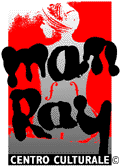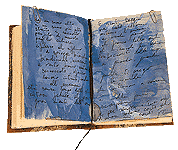
|
|||||||||||||||||||||||

|
Comune di Cagliari Assessorato alla Cultura |
Centro comunale d'arte e cultura |

|
|
Francesco Casu "landscapes of the soul" |

|
||


"Multimedia Codex - Landscapes of the Soul" (2000) video triptych |
|||
Ranging from writing to the electronic image, from primary and elementary manual skill to digital communication and from poetic composition to visual music: this is the wide range of activity which Francesco Casu offers the spectator by way of an installation that includes a video sequence and a small book written and painted by hand. "Landscapes of the Soul" (lasting twelve minutes) are day-to-day fragments which the artist transposes in an atemporal dimension in which the naturalistic reference becomes a trace, a luminous trail that is broken and is recomposed in a multiple vision made up of slowings and sudden accelerations, of meditation and action.
Casu determines a notion of time understood as being the poetic course of things in space. Nature is the origin which it is necessary to recapture in being faced by the insensitiveness of the world. In consequence, the landscape can only be interior, freed from the mechanical flux of the seasons, a landscape of the soul in which one’s eye is capable of regenerating every minimum detail of the real.
The video installation is made up of three monitors. At the centre one finds a mystical image, an icon of an abstract kind that communicates a sense of contemplation played upon the idea of the Oriental mandala before which you slightly ‘let yourself go’, as in a slow perceptive hypnosis. The Zen vision interests the artist, that totality of the present as emptiness in which "everything remains and nothing disappears any longer", a condition that permits saving one’s own breath in the infinite discourse with nature.
At the sides run forms tied to daily life, to the objective presences which come into and go out of the space of life. Forms which are superimposed, that slip onto each other such as a field of flowers, a sky or a pool of water, all letting loose reflections and metamorphoses of light in an inexhaustible flowing of chromatic emotions. The colour is the datum that unites the different rhythms of the images. This is a chromatic writing which the artist constructs after having fixed the intuition of it on the notebook exhibited in front of the three screens as a project from which the computer elaborations are obtained.

The writing in the notebook once again finds the thrill of calligraphy, of those manual rhythms which digital ideology is cancelling due to its own irrevocable reasons. The artist does not give up this out-of-date – or unusual – practice: he writes the poem by hand and recites it out loud inside the flowing of the images that enwrap themselves with a helicoidal movement.
Whereas the reading of the book is slow and calm, requiring real time for its effective completion, the structure of the three-fold visual narration goes beyond whatever expectation and poses itself as the ‘jointing’ of various possibilities of the electronic image: added to the effect of mirroring – vertical, horizontal and diagonal – one has the sense of rotation which permits the creation of perspective series and dynamisms that lead the eye to drift.
From the gliding vision one moves on to the one that sinks within itself. Starting out from the compact colour it moves out to take on crumbled and lacerated effects which spread the image in a mobile play of lights that keeps the spectator in a constant state of apprehension.
The result is a laboratory of interior/spiritual forms in which words and images never come to contradict themselves. If anything they manage to reciprocally integrate themselves in a free play of visual and sound exchanges in which both the music and Casu’s voice increase and strengthen the sense of the dilatation of the image, as particular reflections within the overall flowing of the operation.
This synaesthesia allows the technological adventure to humanize itself in the thought of the artist who is in search for his own being concentrated on the gesture and the sign, but above all on the process of meditation which leads the vision of the colour to make itself a spiritual path, an interior burrowing and an infinite field of appropriation of the invisible of which all things are made.
Francesco Casu
Creator and artistic director of the Tiscali Art multimedia channel, he received his art formation at the Kunsthochschule fur Medien in Koln (Germany), the Centre Georges Pompidou in Paris and at the Galleria Comunale in Cagliari. He has produced various video documentaries for museums and more general educational purposes. The video installations, works directed by him, and his supervision of multimedial installations in Italy and abroad, have to date been innumerable.
Video installations
1999 Videoinstallazione "Blu Oltremare", per Divieto di sosta, Nuoro. 1999 Esposizione della Videoinstallazione "Passio et resurrectio" per Time in Jazz, Berchidda (Sassari). 1998 Ideazione, progettazione e regia dello mostra multimediale "Hortus Artis", Orto Botanico, Cagliari. 1997 Videoinstallazione "La Radeau de la Meduse" per la rassegna Paraphernalia, Iglesias Muratu (Francia). 1996 Videoinstallazione performativa "L’ombra del Silenzio"/2 per la mostra "Il Sacro nell’Arte Contemporanea"; Santuario del Rimedio, Orosei. 1994 Partecipazione al "Babel Project" dell’UNESCO con la videoinstallazione "I am looking for the right train" prodotto dalla Kunsthochschule fur Medien, Koln (Germania). 1993 "Aprendo un Cielo Virtuale", Festival Jazz Internazionale di S. Anna Arresi (Cagliari) 1992 Videoscultura "Beth-El" nell’ambito della Mostra "ArtEl", Galleria Comunale Cagliari. 1990 "Sempre la stessa musica" e "Il giardino" per "Katodos", Galleria Intergrafica, Cagliari. 1989 "Kiklos", cripta di S.Restituta, Cagliari.

